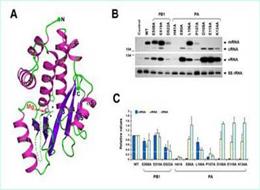
Researchers from the CAS Institute of Biophysics, Nankai University and Tsinghua University have identified the three-dimensional structure of a key region of the H5N1 avian influenza virus that is involved in viral replication. In their article published in Nature, the team led by Liu Yingfang and Rao Zihe propose that this region could constitute an important target for new anti-influenza drugs.
Researchers from the CAS Institute of Biophysics, Nankai University and Tsinghua University have identified the three-dimensional structure of a key region of the H5N1 avian influenza virus that is involved in viral replication. In their article published in Nature, the team led by Liu Yingfang and Rao Zihe propose that this region could constitute an important target for new anti-influenza drugs.
The avian influenza A virus contains the RNA polymerase, an enzyme responsible for directing replication and transcription of viral RNA inside the nuclei of infected cells. Liu and Rao's team determined the crystal structure one of the enzyme's three subunits, called PA, and showed that it has strong endonuclease activity. Host messenger RNA binds to this endonuclease site and is then cleaved, triggering the production of viral messenger RNA.
The H5N1 subtype of the influenza virus is entrenched in poultry worldwide and there is a fear that it could give rise to a pandemic if the virus mutates to transmit efficiently among humans. Of the 405 reported human cases of avian influenza since 2003, 254 have proven fatal. Two drugs are currently available to treat influenza, Tamiflu (Roche) and Relenza (GSK), which it is hoped can be used in the event of a H5N1 pandemic.
However, reports of increasing drug resistance in some H5N1 strains have created the need for effective new anti-influenza drugs. The polymerase genes are the most highly conserved among the influenza virus, and the work by Liu and Rao's team provides a platform for drug design. Their structure can be used as a basis for developing inhibitors, as potential new anti-influenza drugs, that block the function of the PA endonuclease.
At the same time, a French team led by Stephen Cusack has reported an equivalent structure from a H3N2 subtype human influenza virus.
Paper abastract: http://www.nature.com/nature/journal/vaop/ncurrent/abs/nature07720.html
Liu Yingfang's homepage: http://159.226.118.206/detailt.aspx?newsno=8158
Rao Zihe's homepage: http://www.xtal.tsinghua.edu.cn/people/raozh.html





